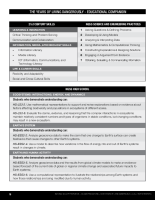
Download the standards tables for High School Lesson 3: NGSS, CCSS, and NCSS.
You can also read the different standards applicable to High School Lesson 3 here.
21st Century Skills
Learning & Innovation
- Critical Thinking and Problem Solving
- Communication and Collaboration
Information, Media, &Technology Skills
- Information Literacy
- Media Literacy
- ICT (Information, Communications, and Technology Literacy
Life & Career Skills
- Flexibility and Adaptability
- Leadership and Responsibility
NGSS Science and Engineering Practices
- Developing & Using Models
- Analyzing & Interpreting Data
- Using Mathematics & Computational Thinking
- Engaging in Argument from Evidence
- Obtaining, Evaluating, & Communicating Information
NGSS – High School
Ecosystems: Interactions. Energy, and Dynamics
Students who demonstrate understanding can:
HS-LS2-2. Use mathematical representations to support and revise explanations based on evidence about factors affecting biodiversity and populations in ecosystems of different scales.
HS-LS2-6. Evaluate the claims, evidence, and reasoning that the complex interactions in ecosystems maintain relatively consistent numbers and types of organisms in stable conditions, but changing conditions may result in a new ecosystem.
Earth’s System
Students who demonstrate understanding can:
HS-ESS2-2. Analyze geoscience data to make the claim that one change to Earth’s surface can create feedbacks that cause changes to other Earth’s systems.
HS-ESS2-4. Use a model to describe how variations in the flow of energy into and out of Earth’s systems result in changes in climate.
Earth and Human Activity
Students who demonstrate understanding can:
HS-ESS3-5. Analyze geoscience data and the results from global climate models to make an evidence-based forecast of the current rate of global or regional climate change and associated future impacts to Earth systems;
HS-ESS3-6. Use a computational representation to illustrate the relationships among Earth systems and how those relationships are being modified due to human activity.
CCSS – ELA/Literacy – High School
Key Ideas and Details
RST.9-10.1 Cite specific textual evidence to support analysis of science and technical texts, attending to the precise details of explanations or descriptions.
RST.11-12.1 Cite specific textual evidence to support analysis of science and technical texts, attending to important distinctions the author makes and to any gaps or inconsistencies in the account.
RST.9-10.2 Determine the central ideas or conclusions of a text; trace the text’s explanation or depiction of a complex process, phenomenon, or concept; provide an accurate summary of the text.
RST.11-12.2 Determine the central ideas or conclusions of a text; summarize complex concepts, processes, or information presented in a text by paraphrasing them in simpler but still accurate terms.
RST.9-10.3 Follow precisely a complex multistep procedure when carrying out experiments, taking measurements, or performing technical tasks, attending to special cases or exceptions defined in the text.
RST.11-12.3 Follow precisely a complex multistep procedure when carrying out experiments, taking measurements, or performing technical tasks; analyze the specific results based on explanations in the text.
RH.9-12.1 Cite specific textual evidence to support analysis of primary and secondary sources, attending to such features as the date and origin of the information.
Craft and Structure
RST.9-12.4 Determine the meaning of symbols, key terms, and other domain- specific words and phrases as they are used in a specific scientific or technical context relevant to grades 9–12 texts and topics.
RST.11-12.4 Determine the meaning of symbols, key terms, and other domain-specific words and phrases as they are used in a specific scientific or technical context relevant to grades 11–12 texts and topics.
RST.9-10.5 Analyze the structure of the relationships among concepts in a text, including relationships among key terms (e.g., force, friction, reaction force, energy).
RH.9-12.4 Determine the meaning of words and phrases as they are used in a text, including vocabulary describing political, social, or economic aspects of history/social science.
RH.11-12.4 Determine the meaning of words and phrases as they are used in a text, including analyzing how an author uses and refines the meaning of a key term over the course of a text.
Integrations of Knowledge and Ideas
RST.9-10.7 Translate quantitative or technical information expressed in words in a text into visual form (e.g., a table or chart) and translate information expressed visually or mathematically (e.g., in an equation) into words.
RST.11-12.7 Integrate and evaluate multiple sources of information presented in diverse formats and media (e.g., quantitative data, video, multimedia) in order to address a question or solve a problem.
RST.11-12.8 Evaluate the hypotheses, data, analysis, and conclusions in a science or technical text, verifying the data when possible and corroborating or challenging conclusions with other sources of information.
RST.9-10.9 Compare and contrast findings presented in a text to those from other sources (including their own experiments), noting when the findings support or contradict previous explanations or accounts.
RST.11-12.9 Synthesize information from a range of sources (e.g., texts, experiments, simulations) into a coherent understanding of a process, phenomenon, or concept, resolving conflicting information when possible.
RH.9-10.7 Integrate quantitative or technical analysis (e.g., charts, research data) with qualitative analysis in print or digital text.
RH.11-12.7 Integrate and evaluate multiple sources of information presented in diverse formats and media (e.g., visually, quantitatively, as well as in words) in order to address a question or solve a problem.
RH.9-10.8 Assess the extent to which the reasoning and evidence in a text support the author’s claims.
RH.11-12.8 Evaluate an author’s premises, claims, and evidence by corroborating or challenging them with other information.
Text Types and Purposes
WHST.9-12.1 Write arguments focused on discipline-specific content.
WHST.9-10.2 Write informative/ explanatory texts, including the narration of historical events, scientific procedures/ experiments, or technical processes.
Production and Distribution of Writing
WHST.9-12.4 Produce clear and coherent writing in which the development, organization, and style are appropriate to task, purpose, and audience.
Research to Build and Present Knowledge
WHST.9-12.7 Conduct short as well as more sustained research projects to answer a question (including a self-generated question) or solve a problem; narrow or broaden the inquiry when appropriate; synthesize multiple sources on the subject, demonstrating understanding of the subject under investigation.
WHST.9-12.9 Draw evidence from informational texts to support analysis, reflection, and research.
Range of Writing
WHST.9-12.10 Write routinely over extended time frames (time for reflection and revision) and shorter time frames (a single sitting or a day or two) for a range of discipline- specific tasks, purposes, and audiences.
NCSS – High School
Culture
Learner will understand:
- That behaviors, values, and beliefs, of different cultures can lead to cooperation or pose barriers to cross-cultural understanding;
- That awareness and knowledge of other cultures is important in a connected society and an interdependent world;
- That the cultural values and beliefs of societies influence their analysis of challenges, and their responses to these challenges.
Learners will be able to:
- Construct reasoned judgments about specific cultural responses to persistent human issues.
Time, Continuity, and Change
Learners will understand:
- The importance of knowledge of the past to an understanding of the present and to informed decision-making about the future.
People, Places, & Environments
Learners will understand:
- The theme of people, places, and environments involves the study of the relationships between human populations in different locations and regional and global geographic phenomena, such as landforms, soils, climate, vegetation, and natural resources;
- Concepts such as: location, physical and human characteristics of national and global regions in the past and present, and the interactions of humans with the environment;
- Consequences of changes in regional and global physical systems, such as seasons, climate, and weather, and the water cycle;
- The causes and impact of resource management, as reflected in land use, settlement patterns, and ecosystem changes;
- The social and economic effects of environmental changes and crises resulting from phenomena such as floods, storms, and drought;
- The use of a variety of maps, globes. Graphic representations, and geospatial technologies to help investigate spatial relations, resources, and population density and distribution, and changes in these phenomena over time.
Learners will be able to:
- Acquire, organize, and analyze geographic information from data sources, geographic tools and geospatial technologies such as aerial photographs, satellite images, geographic information systems (GIS) to determine patterns;
- Evaluate the consequences of human actions in environmental terms.
Individual Development and Identity
Learners will be able to:
- Discuss the nature of stereotyping, bias, altruism, and conformity in societies, and their implications for personal, group, and national relationships.
Individual, Groups, and Institutions
Learners will understand:
- How various forms of groups and institutions change over time;
- The impact of tensions and examples of cooperation between individuals, groups, and institutions, with their different belief systems;
- How the beliefs of dominant groups tend to become norms in a society;
- How groups and institutions work to meet individual needs, and can promote the common good and address persistent social issues.
Power, Authority, and Governance
Learners will understand:
- Mechanisms by which governments meet the needs and wants of citizens, regulate territory, manage conflict, establish order and security, and balance competing conceptions of a just society.
Learners will be able to:
- Analyze and evaluate conditions, actions, and motivations that contribute to conflict and cooperation among groups and nations.
Science, Technology, and Society
Learners will understand:
- Science and technology have had both positive and negative impacts upon individuals, societies, and the environment in the past and present;
- That the world is media saturated and technologically dependent;
- Consequences of science and technology for individuals and societies;
- Decisions regarding the uses and consequences of science and technology are often complex because of the need to choose between or reconcile different viewpoints;
- Prediction, modeling, and planning are used to focus advances in science and technology for positive ends;
- Developments in science and technology may help to address global issues.
Learners will be able to:
- Use diverse types of media technology to access, analyze, evaluate, create, and distribute messages;
- Identify the purposes, points of view, biases, and intended audience of reports and discussions related to issues involving science and technology.
Global Connections
Learners will understand:
- The solutions to global issues may involve individual decisions and actions, but also require national and international approaches (e.g. agreements, negotiations, policies, or laws);
- The actions of people, communities, and nations have both short – and long-term effects on the biosphere and its ability to sustain life;
- Individuals, organizations, nations, and international entities can work to increase the positive effects of global connections, and address the negative impacts of global issues.
Learners will be able to:
- Analyze the cause and consequences of persistent, contemporary, and emerging global issues, and evaluate possible solutions.
Civic Ideals and Practices
Learners will understand:
- The theme of civic ideals and practices helps us recognize where gaps between ideals and practices exist, and prepares us to work for social justice;
- That seeking multiple perspectives is required in order to effectively grasp the complexity of issues involving civic ideals and practices;
- The importance of becoming informed as the basis for thoughtful and positive contributions through civic action.
Learners will be able to:
- Ask and find answers to questions about how to become informed and take civic action;
- Research primary and secondary sources to make decisions and propose solutions to selected civic issues in the past and present;
- Identify assumptions, misconceptions, and biases in sources, evidence, and arguments used in presenting issues and positions;
- Develop a position on a public policy issue and defend it with evidence.


